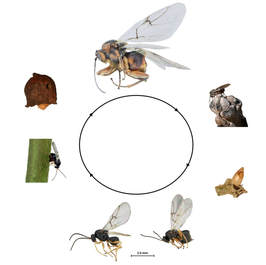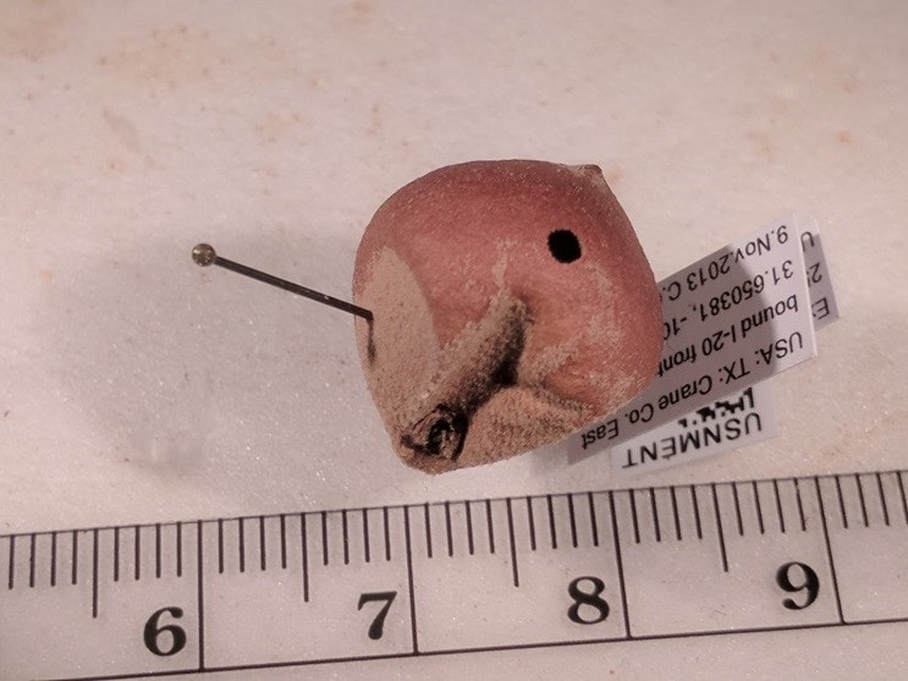 The lifecycle of gall wasps, beginning with an asexual female (top center), that lays eggs into the dormant buds (top right) forming bud galls (bottom right). Those galls then give rise to the sexual generation (center bottom), which lay eggs in twigs (bottom left). This forms a woody twig gall, which harbors the asexual female. The lifecycle of gall wasps, beginning with an asexual female (top center), that lays eggs into the dormant buds (top right) forming bud galls (bottom right). Those galls then give rise to the sexual generation (center bottom), which lay eggs in twigs (bottom left). This forms a woody twig gall, which harbors the asexual female. The gall wasp tree of life is overdue for a major overhaul. With the help of new genetic technologies and the hard work of Crystal Cooke (Dept. Entomology, University of Maryland), we have a better understanding of the relationships between gall wasp species and clades.  Figure 1. Image of a gall wasp, Disholcaspis sp. Provided by Crystal Cooke. Figure 1. Image of a gall wasp, Disholcaspis sp. Provided by Crystal Cooke. What’s the best way to identify a species of gall wasp? Turns out it’s not by examining the wasp itself, but instead looking at the gall it produces on the host plant. With this obstacle in mind Crystal Cooke, a PhD candidate and soon-to-be Doctor of Entomology at the University of Maryland, has spent the past eight years studying the taxonomy and systematics of galls wasps across the globe (tribe Cynipini, ~1000 recognized species). With few distinguishing characteristics on the insects themselves, Crystal made use of new technologies and techniques to decipher the diversity and evolutionary relationships of the gall wasps. Gall wasps are small, neutral colored plant parasites that elicit a strange reaction from their host plants (Fig. 1). The gall wasps are able to stimulate a buildup of plant tissues surrounding them, which becomes both home and food for the immature wasp (Fig. 2). Although these galls are often species-specific in shape, color, size, host plant, and location, the relationship between different species of gall wasps remains shrouded in uncertainty. Cooke’s research centers around discovering how many species of gall wasps exist today and how they fit onto the tree of life. One of the best and newest ways to answer these questions is to use Ultra Conserved Elements (UCEs). These are regions of the genome that are exactly the same between species, but the flanking regions (the sections immediately before and after the UCE) have changed over time and can help scientists track the evolution of different species. Using UCEs, Cooke was able to identify several genera of gall wasps that are polyphyletic (a group of organisms that do not share a recent common ancestor), suggesting that our current hypotheses of evolutionary relationships need a major overhaul. One of the explanations for this problem is that the global distribution of wasps has changed through time, with several groups shifting between the Palearctic (northern Africa, Europe, and northern Asia) and Nearctic (North America) realms. This led to scientists overlooking the relationships between gall wasps on different continents.  Figure 3. The lifecycle of gall wasps, beginning with an asexual female (top center), that lays eggs into the dormant buds (top right) forming bud galls (bottom right). Those galls then give rise to the sexual generation (center bottom), which lay eggs in twigs (bottom left). This forms a woody twig gall, which harbors the asexual female. Figure 3. The lifecycle of gall wasps, beginning with an asexual female (top center), that lays eggs into the dormant buds (top right) forming bud galls (bottom right). Those galls then give rise to the sexual generation (center bottom), which lay eggs in twigs (bottom left). This forms a woody twig gall, which harbors the asexual female. Cooke also evaluated the phylogeny of gall wasps in the genus Disholcaspis, also known as bullet gall wasps, which are a unique group of gall wasps. These wasps utilize oak trees (Fagaceae) in the genus Quercus to create galls across North and Central America. In addition to the already fascinating life history associated with gall making, these wasps are also ant mutualists, wherein their galls secrete nectar that attracts ants, which in return for the sweet treat, provide protection to the gall. This nectar can also attract nuisance pests, such as yellow jackets, which was the inspiration for Cooke’s Master’s research project. A major focus of Cooke’s PhD research was identifying sexual generations of gall wasps in the genus Disholcaspis, as gall wasps have the unique ability to alternate between sexual and asexual generations (Fig. 3). During a nationwide expedition to collect galls and host plant vouchers, Cooke came across a unique looking gall on an oak species that lives on sand dunes in Texas. She knew right away that she had found a new species of Disholcaspis, which she is naming based on its smooth, mammaform gall (formal description pending; Fig. 4). These tiny wasps can be difficult to describe using morphological cues, although after extensive visual inspection Cooke was able to identify unique combinations of coloration and patterns, as well as a unique hypopygial spine length, found on the abdomen protecting the ovipositor (egg-laying structure), often used to describe these wasps. Cooke has used her expertise to rectify the phylogenies of these wasps and provide genetic information, morphological descriptions, vouchers, and images to the tree of life! Her work has helped to unravel part of the mystery of evolution within these small, but extraordinary organisms. Blog authors:
S. Augusta Maccracken is a 4th year PhD Candidate in the Department of Entomology at the University of Maryland, College Park and in the Department of Paleobiology at the Smithsonian Institution National Museum of Natural History. She studies insect mediated damage on fossil leaves to reconstruct ancient plant-insect associations. Jackie Hoban is a Masters Student in the Department of Entomology at the University of Maryland, College Park. She studies emerald ash borer biological control under the direction of Dr. Paula Shrewsbury. Comments are closed.
|
Categories
All
Archives
June 2024
|
Department of Entomology
University of Maryland
4112 Plant Sciences Building
College Park, MD 20742-4454
USA
Telephone: 301.405.3911
Fax: 301.314.9290
University of Maryland
4112 Plant Sciences Building
College Park, MD 20742-4454
USA
Telephone: 301.405.3911
Fax: 301.314.9290



 RSS Feed
RSS Feed




